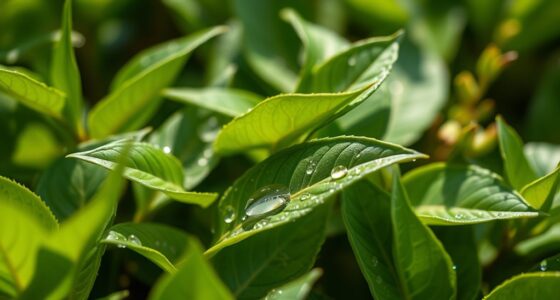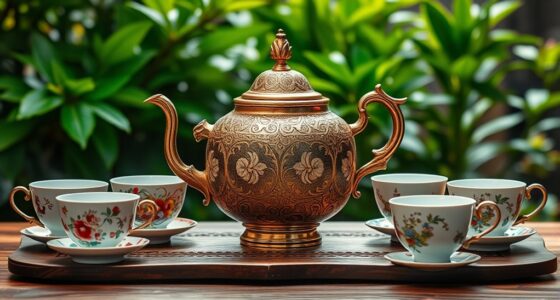Assam Orthodox tea is processed by traditional plucking and rolling, which preserves whole leaves and aromatic oils, resulting in a rich aroma and nuanced flavor that are favored by connoisseurs. In contrast, CTC breaks down leaves into small pieces using mechanical shredding, producing a bold, consistent taste ideal for quick brewing and mass markets. If you want to understand how these methods influence your tea experience, exploring further will reveal more about their differences.
Key Takeaways
- Orthodox Assam tea is processed using traditional plucking and rolling, preserving whole leaves and aromatic oils, resulting in a nuanced flavor.
- CTC Assam tea is mechanically shredded into small pieces, producing broken leaves and fannings, leading to a bold, consistent cup.
- Orthodox teas offer a richer aroma and complex taste, ideal for connoisseurs, while CTC provides a strong, quick-brewing tea suited for everyday consumption.
- Orthodox processing maintains higher quality and natural flavors, often marketed as premium, whereas CTC is more economical and mass-market focused.
- The choice depends on preference: Orthodox for aromatic, nuanced cups; CTC for robust flavor with convenience and quick preparation.

When choosing between Assam Orthodox and CTC tea, understanding their differences can help you make an informed decision. Both types originate from the same region but differ markedly in processing methods, which directly impact their flavor, strength, and overall character. One of the key factors to consider is tea leaf quality. Orthodox tea is made using traditional, careful plucking and rolling techniques that preserve the integrity of the leaves. This approach tends to select high-quality, whole leaves, which retain more of their aromatic oils and natural flavors. As a result, Orthodox tea often has a richer aroma and a more nuanced taste profile. Conversely, CTC (Crush, Tear, Curl) processing involves mechanically shredding the leaves into smaller pieces. This method is faster and more economical, but it usually results in broken leaves and fannings, which can diminish the complexity of flavors. The tea leaf quality in CTC is generally lower compared to Orthodox, but it offers consistency and strength, making it popular for mass-market applications.
Market preferences play a vital role in shaping which type of tea is more widely consumed. Orthodox teas are often favored by connoisseurs and those who appreciate a refined, aromatic cup. They are typically marketed as premium products, highlighting their traditional processing and superior leaf integrity. On the other hand, CTC teas dominate the mass market due to their affordability, strength, and quick brewing qualities. They are especially popular in markets where consumers prefer a bold, brisk brew, such as in instant tea blends or everyday grocery store shelves. The market’s demand for convenience and consistent strength has driven the popularity of CTC, even though it may sacrifice some of the subtleties found in Orthodox teas.
If you’re someone who enjoys a complex, aromatic cup, Orthodox tea might appeal more to your palate. It’s ideal for brewing in a way that allows the full range of flavors to develop, often served without milk to savor the delicate nuances. Meanwhile, if you prefer a strong, robust tea that can stand up to milk and sugar, CTC is your go-to option, especially for quick mornings or large-volume brewing. Understanding these distinctions helps you select a tea that aligns with your taste preferences and the market’s prevailing trends. Ultimately, whether you choose Orthodox or CTC, knowing how processing impacts tea leaf quality and market appeal guarantees you get the best experience from your cup.
Frequently Asked Questions
Which Tea Type Is More Environmentally Sustainable?
You’ll find organic-certified teas generally more environmentally sustainable because they use fewer chemicals, reducing soil and water pollution. Organic tea often requires less water during cultivation, which helps conserve water resources. By choosing organic, you support eco-friendly farming practices that minimize environmental impact. So, if sustainability matters to you, opt for organic-certified tea, as it promotes better water usage and reduces harmful chemical runoff, benefiting the environment overall.
How Do Storage Requirements Differ Between Orthodox and CTC Teas?
Think of storage like guarding treasure. Orthodox teas require careful storage conditions, often in airtight, light-proof containers to preserve their delicate flavors. CTC teas, with their larger particles, are more forgiving and can be stored in simpler packaging, but still need dryness and coolness. Packaging differences reflect this: orthodox teas often come in tins or foil, while CTC teas are usually in bulk or paper bags, making them easier to store.
Are There Specific Health Benefits Linked to Either Processing Method?
You might notice that Orthodox teas often retain higher antioxidant levels due to gentler processing, which can offer more health benefits. CTC teas, on the other hand, usually have higher caffeine content, providing a quick energy boost. Both methods can contribute to your health in different ways; choose based on whether you’re seeking antioxidants or a caffeine punch. Your preference influences the potential health benefits you get from each tea.
Which Tea Type Is More Popular in International Markets?
You’ll find that CTC tea is more popular in international markets due to its strong flavor, quick brew, and consistent quality. Market demand for CTC has surged, especially in countries seeking budget-friendly, robust teas. Export trends favor CTC because it’s easier to process and store, making it a preferred choice worldwide. If you’re exploring global tea options, CTC’s popularity reflects its widespread acceptance and reliable supply chain.
How Do Brewing Times Vary for Orthodox and CTC Teas?
Think of brewing as a dance where timing guides the flavor. Orthodox teas, with their delicate leaves, need a longer brewing duration—around 3 to 5 minutes—to fully extract their nuanced flavors. CTC teas, like a swift tap dance, require just 2 to 3 minutes, releasing robust flavors quickly. Adjust brewing times based on your preferred strength to achieve perfect flavor extraction.
Conclusion
When choosing between Assam Orthodox and CTC, you get to decide based on your taste preference. notably, CTC teas make up about 70% of India’s total tea production, highlighting their popularity. Orthodox teas, though less common, offer a more nuanced flavor profile. So, whether you prefer the robust, brisk CTC or the delicate, complex Orthodox, both bring something unique to your cup. Your perfect brew awaits—it’s just a matter of taste!










